Needle guides for Esaote Transducers
Victor Duran2024-11-22T14:05:51-05:00Reusable & Disposable Ultrasound Needle Guides for Esaote
We offer needle guides for most Esaote ultrasound transducers. Check the label on the connector to identify your transducer’s model and find it in the list below (in alphabetical order).
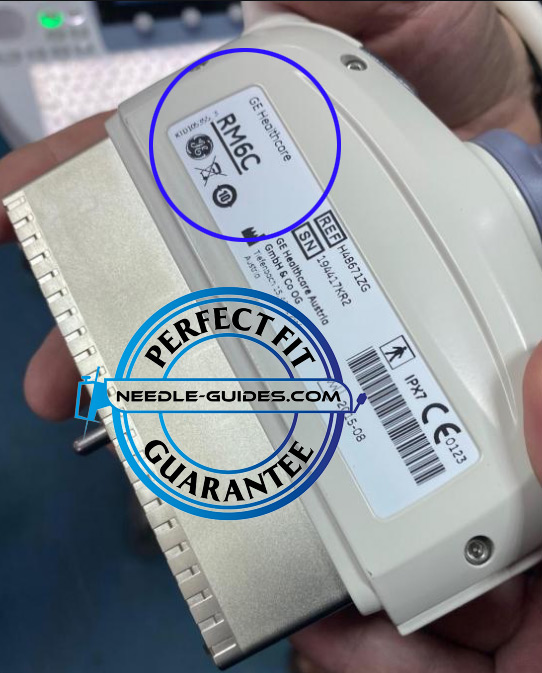
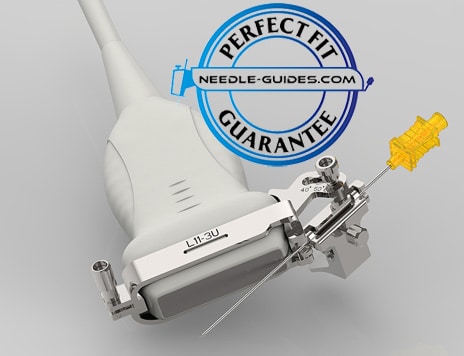
Reusable Linear Esaote Ultrasound Needle Guides
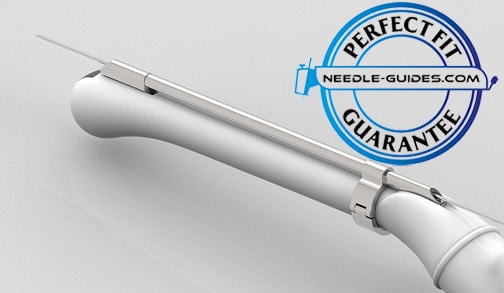
Reusable Transvaginal Esaote Ultrasound Needle Guides
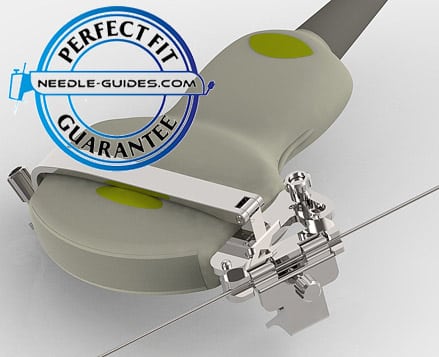
Reusable Convex Esaote Ultrasound Needle Guides
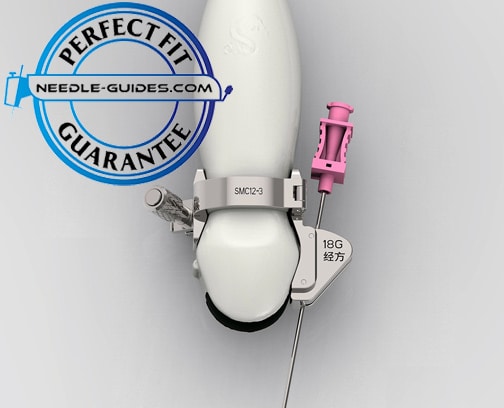
Reusable Microconvex Esaote Ultrasound Needle Guides
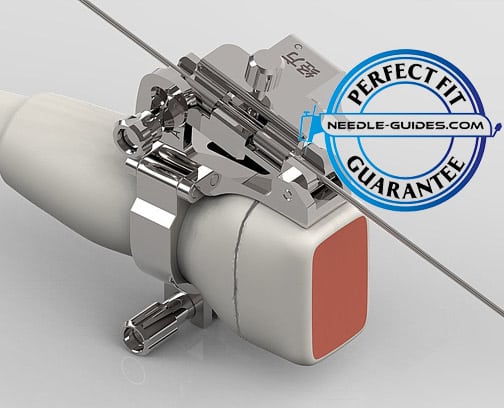
Reusable Phased Array Esaote Ultrasound Needle Guides
| Esaote SP2730 Transducer Needle Guide – Reusable | Phased Array |
| Esaote SP2430 Transducer Needle Guide – Reusable | Phased Array |
| Esaote PA250 Transducer Needle Guide – Reusable | Phased Array |
| Esaote PA240 Transducer Needle Guide – Reusable | Phased Array |
| Esaote PA230E Transducer Needle Guide – Reusable | Phased Array |
| Esaote P1-5 Transducer Needle Guide – Reusable | Phased Array |
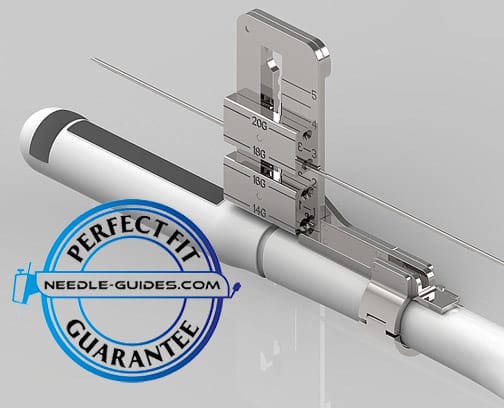
Reusable Biplane Transrectal Esaote Ultrasound Needle Guides
| Esaote TLC3-13 Transducer Needle Guide – Reusable | Biplane Transrectal |
| Esaote TRT33 Transducer Needle Guide – Reusable | Biplane Transrectal |
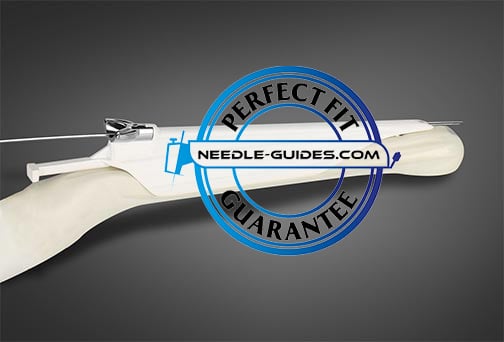
Disposable Esaote Ultrasound Needle Guides

Can't find your Esaote ultrasound needle guide? We can help!
Ultrasound Needle Guide Quotation request
"*" indicates required fields



TRANSVAGINAL & ENDOCAVITY NEEDLE GUIDES FOR ESAOTE PROBES
A needle guide mounted on your Esaote endocavity transducer is commonly used for ultrasound-guided procedures that involve accessing organs or structures through body cavities. Specifically, the endocavity transducer is specifically designed for imaging within body cavities, such as the rectum, vagina, or esophagus, and provides high-resolution images in close proximity to the target area. Correspondingly, a needle guide attached to an endocavity transducer, facilitates accurate needle placement and enhances procedural guidance for various medical purposes, including:
Transrectal prostate procedures: A needle guide mounted on your Esaote endocavity transducer assists in accurately targeting the prostate gland in procedures such as prostate biopsies or brachytherapy. In this situation, it helps guide the biopsy needle or the radioactive seeds to the desired locations within the prostate, ensuring precise sampling or treatment delivery.
Transvaginal interventions: A needle guide installed on your Esaote endocavity transducer can be used for interventions such as cyst aspirations or uterine fibroid ablations in gynecological procedures. For this purpose, the needle guide allows for precise needle placement in therapeutic interventions targeting cysts or fibroids within the vagina or uterus.
Endorectal interventions: A needle guide fitted your Esaote endocavity transducer can be utilized for interventions such as biopsies or abscess drainages in procedures involving the rectum or anal canal. Specifically, it helps guide the needle to the target area within the rectum, facilitating accurate sampling or drainage procedures.
Endoscopic ultrasound-guided interventions: A needle guide equipped with your Esaote endocavity transducer can be used for precise fine-needle aspirations or injections in endoscopic procedures. In this case, it provides real-time visualization and precise needle guidance for sampling or therapeutic interventions within the gastrointestinal tract, such as the esophagus, stomach, or rectum.
In summary, a needle guide mounted on your Esaote endocavity transducer enables accurate and real-time visualization during procedures within body cavities. It improves the safety, accuracy, and success rates of needle placements, reducing the risk of complications and improving patient outcomes.

LINEAR ULTRASOUND NEEDLE GUIDES FOR ESAOTE PROBES
A needle guide mounted on your Esaote linear transducer is commonly used for ultrasound-guided procedures that require a linear imaging format. Specifically, the linear transducer has a rectangular or linear shape, providing a high-resolution image in a narrow field of view. Correspondingly, the needle guide, in combination with the linear transducer, facilitates accurate needle placement and enhances procedural guidance for various medical purposes, including:
Musculoskeletal interventions: A needle guide installed on your Esaote linear transducer is often used for ultrasound-guided injections and aspirations in musculoskeletal procedures. For this purpose, it assists in precisely targeting joints, bursae, tendons, and muscles, allowing for accurate delivery of medications, such as corticosteroids or local anesthetics, or for aspiration of fluid or cysts.
Interventional radiology: A needle guide used with your Esaote linear transducer can be utilized for biopsies, abscess drainages, or tumor ablations in interventional radiology procedures. With this in mind, it helps guide the needle to the desired target within the liver, kidneys, breast, thyroid, or other superficial or deep-seated structures, ensuring accurate placement and minimizing the risk of complications.
Vascular procedures: A needle guide mounted on a linear transducer assists in identifying and accessing the blood vessel with precision during vascular access procedures, such as ultrasound-guided arterial or venous catheterizations. Therefore, this allows for safer and more effective catheter insertions, reducing the risk of complications like arterial puncture or hematoma formation.
Regional anesthesia and pain management: A needle guide installed on your Esaote linear transducer can aid in accurately targeting specific nerves or nerve clusters for nerve blocks or pain management procedures. For this reason, this enables the anesthesiologist to deliver local anesthetic agents precisely, resulting in effective pain relief or anesthesia for surgeries.
In summary, the use of a needle guide fitted with your Esaote linear transducer enhances visualization and improves the accuracy of needle placement, increasing procedural success rates and patient safety.

CONVEX ULTRASOUND NEEDLE GUIDES FOR ESAOTE PROBES
A needle guide mounted on your Esaote convex transducer is typically used for ultrasound-guided procedures that involve the insertion of a needle or catheter into the body. Specifically, the convex transducer refers to the type of ultrasound probe that has a curved or convex shape, allowing for a wider field of view and deeper penetration into the body.
Therefore, the needle guide serves as a tool to assist in accurate and precise needle placement during procedures such as:
Biopsy: A needle guide mounted on your Esaote can be used during ultrasound-guided biopsies, where a tissue sample is obtained for diagnostic purposes. For this purpose, the guide helps in aligning the needle with the target tissue, ensuring that the biopsy is performed at the desired location.
Aspiration and drainage: A needle guide fitted on your Esaote transducer can be used to guide the needle precisely to the desired location in procedures that involve draining fluid collections or aspirating fluid from a specific area, while minimizing the risk of damaging surrounding structures.
Nerve blocks and regional anesthesia: A needle guide mounted on your Esaote convex transducer can assist in accurate needle placement near nerves or specific anatomical landmarks during nerve blocks or regional anesthesia procedures. In particular, this helps in delivering local anesthetic agents precisely, ensuring effective pain management or surgical anesthesia.
Vascular access: A needle guide used with your Esaote transducer can aid in identifying and targeting the desired blood vessel accurately when inserting a central venous catheter or performing peripheral vascular access. In this case, facilitating in successful cannulation and reducing the risk of complications.
In summary, a needle guide mounted on your Esaote convex transducer provides real-time visualization and guidance, allowing medical professionals to perform procedures with increased precision, reduced risk, and improved patient outcomes.

MICRO CONVEX ULTRASOUND NEEDLE GUIDES FOR ESAOTE PROBES
A needle guide mounted on your Esaote micro convex transducer is typically used for ultrasound-guided procedures that require imaging in small or confined spaces. Specifically, the micro convex transducer has a small convex shape, allowing for improved imaging in areas where access is limited. Correspondingly, the needle guide, in combination with the micro convex transducer, facilitates accurate needle placement and enhances procedural guidance for various medical purposes, including:
Transesophageal echocardiography (TEE): In TEE procedures, a needle guide on your Esaote micro convex transducer can be used for guidance during transseptal punctures. For this purpose, it helps in accurately directing the needle through the interatrial septum of the heart, enabling access to the left atrium for interventions such as atrial septal defect closure or ablation procedures.
Pediatric procedures: A needle guide equipped with your Esaote micro convex transducer can aid in accurate needle placement when performing ultrasound-guided procedures on pediatric patients. In particular, it can be used for procedures such as vascular access, joint injections, or biopsies in small anatomical structures.
Neonatal and infant cranial procedures: A needle guide fitted on your Esaote micro convex transducer can assist in procedures such as lumbar punctures or intraventricular catheter placements in neonatal and infant care. With this in mind, it helps in guiding the needle accurately for cerebrospinal fluid collection or neurosurgical interventions while minimizing the risk of complications.
Small parts interventions: The needle guide mounted on your Esaote micro convex transducer can also be used for procedures involving small organs or structures such as the thyroid, salivary glands, or superficial masses. In this situation it assists in accurate needle placement for biopsies, aspirations, or therapeutic injections.
In summary, the use of a needle guide fitted on your Esaote micro convex transducer allows for improved visualization and precise guidance in small or challenging anatomical spaces. It enhances procedural accuracy, reduces the risk of complications, and improves patient outcomes.

PHASED ARRAY ULTRASOUND NEEDLE GUIDES FOR ESAOTE PROBES
A needle guide mounted on your Esaote phased array transducer can be used for ultrasound-guided procedures that require imaging with a phased array technology. Specifically, the phased array transducer uses multiple small elements to generate and steer ultrasound beams electronically, allowing for real-time imaging of a wide field of view. Correspondingly, the needle guide, in combination with the phased array transducer, facilitates accurate needle placement and enhances procedural guidance for various medical purposes, including:
Cardiac procedures: A needle guide on your Esaote phased array transducer can aid in procedures such as pericardiocentesis or myocardial biopsies in cardiac interventions. For this purpose, it helps guide the needle accurately to the target area within the heart, allowing for precise sampling or fluid drainage.
Transcranial Doppler (TCD): During TCD examinations, a needle guide used in conjunction with your Esaote phased array transducer can be utilized for procedures such as transcranial Doppler monitoring or embolism detection. In this situation, it assists in accurately positioning the transducer to obtain optimal ultrasound signals through the skull, enhancing the accuracy and reliability of the diagnostic measurements.
Transesophageal echocardiography (TEE): For TEE procedures, a needle guide on your Esaote phased array transducer can aid in transseptal punctures or interventions within the heart. In particular, it provides guidance for accurate needle placement through the interatrial septum or imaging guidance during intracardiac procedures.
Abdominal and pelvic interventions: A needle guide on your Esaote phased array transducer can assist in interventions such as biopsies, fluid aspirations, or drainages in certain abdominal or pelvic procedures. With this in mind, it enables accurate needle placement while providing a wide field of view for visualizing the target organ or structure.
In summary, the use of a needle guide fitted on your Esaote phased array transducer allows for real-time imaging and precise needle guidance in various medical procedures. It enhances procedural accuracy, improves visualization, and contributes to better patient outcomes.

NEEDLE GUIDES FOR BI-PLANE TRANSRECTAL ESAOTE PROBES
A needle guide mounted on your Esaote biplane transducer is used for specialized ultrasound-guided procedures that require imaging from two perpendicular planes simultaneously. Specifically, the biplane transducer consists of two transducer elements oriented at right angles to each other, providing real-time imaging in orthogonal planes. Correspondingly, a needle guide mounted on a biplane transducer, facilitates accurate needle placement and enhances procedural guidance for specific medical purposes, including:
Transrectal prostate interventions: A needle guide on your Esaote biplane transducer can assist in accurate needle placement within the prostate gland in transrectal procedures such as prostate biopsies or brachytherapy. In similar fashion, the dual-plane imaging capability allows for precise targeting and sampling from different angles, improving the diagnostic yield and reducing the risk of complications.
Cardiac interventions: A needle guide fitted on your Esaote biplane transducer can aid in accurate needle placement or device positioning during certain cardiac procedures, such as transcatheter structural heart interventions. As a result, the biplane imaging helps visualize the cardiac structures from multiple angles, facilitating precise guidance and ensuring optimal procedural outcomes.
Neurosurgical procedures: A needle guide mounted on your Esaote biplane transducer can be used for interventions such as stereotactic biopsies or intracranial interventions in neurosurgery. At the same time, the biplane imaging allows for accurate targeting of brain lesions or structures from different angles, improving the precision and safety of the procedures.
Orthopedic interventions: A needle guide used with your Esaote biplane transducer can aid in accurate needle placement for certain orthopedic procedures, such as joint injections or aspirations. For this purpose, the dual-plane imaging enables better visualization of the joint space or surrounding structures, enhancing procedural accuracy and reducing the risk of complications.
In summary, a needle guide fitted on your Esaote biplane transducer provides simultaneous imaging from orthogonal planes, allowing for enhanced visualization and precise needle guidance in specific medical procedures. It improves procedural accuracy, reduces complications, and contributes to better patient outcomes in these specialized interventions.
